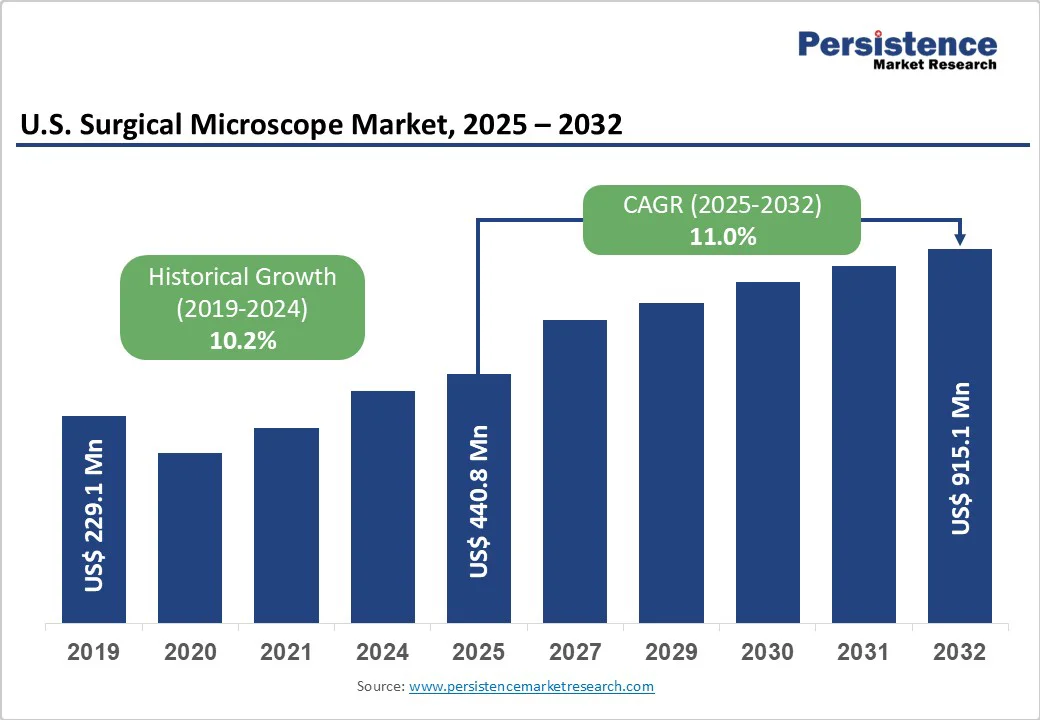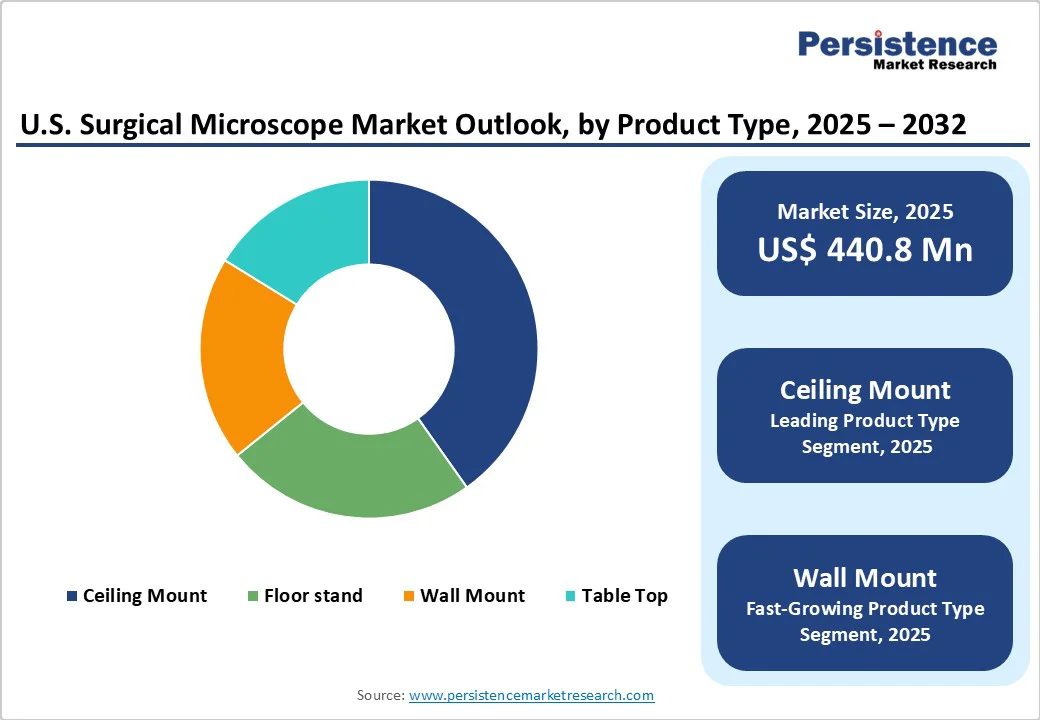ID: PMRREP35723| 173 Pages | 14 Oct 2025 | Format: PDF, Excel, PPT* | Healthcare

The U.S. surgical microscope market size is likely to be valued at US$440.8 Mn in 2025 and projected to reach US$915.1 Mn by 2032, growing at a CAGR of 11.0% during the forecast period from 2025 to 2032.
The U.S. surgical microscope market is driven by technological innovations and the rising number of minimally invasive surgeries across the country. Growth is further supported by the launch of advanced surgical microscopes featuring 3D visualization and digital integration, which enhance surgical precision, ergonomics, and workflow efficiency in operating rooms.
| U.S. Surgical Microscope Market Attribute | Key Insights |
|---|---|
| U.S. Surgical Microscope Market Size (2025E) | US$440.8 Mn |
| Market Value Forecast (2032F) | US$915.1 Mn |
| Projected Growth (CAGR 2025 to 2032) | 11.0% |
| Historical Market Growth (CAGR 2019 to 2024) | 10.2% |

In the U.S., the rapid shift and upgradation from optical to digital microscopes, 3D microscopes, and fluorescence imaging are driving market growth. Digital platforms also enable the integration of operating rooms (ORs) and teaching, accelerating procurement by academic hospitals and private chains seeking better outcomes and improved medico-legal records.
For instance, in April 2025, Leica Microsystems launched Proveo 8x, a 3D digital ophthalmic microscope with real-time 3D imaging, at the Annual Meeting of the American Society of Cataract and Refractive Surgery (ASCRS) in California, U.S.
The rising demand for minimally invasive surgeries is prompting hospitals to adopt surgical microscopes for their superior magnification, ergonomics, and improved outcomes. This drives device purchases in tertiary and specialty centers as surgeons prefer surgical microscopes for precision tasks that reduce complications and OR time.
For instance, in 2024, according to the International Society of Aesthetic Plastic Surgery, the U.S. performed the most procedures worldwide, with over 6.1 million procedures in 2023. Thus, driving the surgical microscope market growth in the region.
Surgical microscopes equipped with advanced imaging, optics, lighting, and video integration often carry a price tag in the hundreds to thousands of dollars. For hospitals or surgical centers operating under tight capital budgets, this represents a significant restraint in market growth. Smaller facilities and ambulatory surgical centers (ASCs) may find such purchases financially challenging.
Additionally, these devices are highly precise optical instruments that require regular maintenance, calibration, and occasional replacement of critical components such as lenses, light sources, sensors, and camera systems. These recurring operational costs, covering service contracts, parts replacement, and technical support, further increase the total cost of ownership, making it more difficult for smaller or resource-limited institutions to justify investment.
The U.S. is witnessing a steady rise in ambulatory surgical centers, driven by the shift toward cost-effective, outpatient care. Procedures such as ophthalmic, ENT, spine, and plastic surgeries are increasingly performed in Ambulatory Surgery Centers (ASC) due to lower costs, faster turnaround times, and favorable Centers for Medicare & Medicaid Services (CMS) reimbursement policies.
This creates strong demand for compact, mobile, and affordable surgical microscopes that fit smaller operating rooms and offer flexible financing or service models. Manufacturers can tap into this by developing portable solutions, lease/rental models, and tailored service contracts for ASC.
For instance, according to the Society for Cardiovascular Angiography & Interventions, the ASC volume is anticipated to increase by 21% between 2024 to 2034. The shift to ASC is primarily due to the potential for cost savings, innovation in clinical diagnostics, and the growing aging population in need of care.
The ceiling mount leads the market with an approximate40.2% share in 2025. The ceiling mount segment dominates the U.S. surgical microscope market due to its stable installation, ability to free up valuable floor space, and suitability for high-traffic operating rooms.
These systems provide unobstructed movement, enhanced ergonomics, and seamless integration with advanced imaging and lighting technologies, making them the preferred choice for complex and high-volume surgeries in hospitals and specialty centers.
Ophthalmology dominates the U.S. surgical microscope market due to the high volume of eye-related surgeries such as cataract, glaucoma, and retinal procedures. The increasing prevalence of vision disorders and an aging population drives demand for precise, high-quality visualization.
Additionally, ophthalmic surgeries require advanced optics, illumination, and magnification, making surgical microscopes essential. For instance, according to the University of Florida Health, approximately 4 million cataract surgeries are performed in the U.S. every year.
This rise in ophthalmology procedures drives demand for advanced surgical microscopes with high-precision optics, superior illumination, and integrated imaging systems, enabling surgeons to perform delicate eye surgeries with enhanced accuracy and improved patient outcomes.
The ENT segment is the fastest-growing in the U.S. surgical microscope market, driven by the rising prevalence of ear, nose, and throat disorders and the increasing number of procedures, including functional endoscopic sinus surgery, stapedectomy, and skull-base surgeries.
The demand is further driven by advancements in fluorescence imaging, high-definition optics, and precision-guided surgical techniques, which allow surgeons to operate effectively in narrow anatomical spaces.

The U.S. surgical microscope market is competitive, led by players such as Danaher Corporation, ZEISS Group, Labo America, Inc., Alcon Inc., and B. Braun SE. These companies focus on innovating advanced imaging and optical technologies, expanding product portfolios, and enhancing device ergonomics.
They also invest in mergers and acquisitions and strategic partnerships to strengthen their market presence. Additionally, many prioritize R&D for AI integration, 3D visualization, and heads-up displays, aiming to improve surgical precision and meet the growing demand across ophthalmology, ENT, neurology, and other specialties.
The U.S. surgical microscopes market is projected to be valued at US$440.8 Mn in 2025.
Technological innovations such as 3D and digital imaging, and the growing volume of minimally invasive and outpatient surgeries, are increasing demand across hospitals and surgical centers.
The U.S. surgical microscopes market is poised to witness a CAGR of 11.0% between 2025 and 2032.
Key opportunities in the U.S. surgical microscope market include technological advancements, rising minimally invasive surgeries, growing ophthalmic procedures, and increasing hospital investments.
| Report Attribute | Details |
|---|---|
| Historical Data/Actuals | 2019 - 2024 |
| Forecast Period | 2025 - 2032 |
| Market Analysis | Value: US$ Mn, Volume: Units |
| Geographical Coverage |
|
| Segmental Coverage |
|
| Competitive Analysis |
|
| Report Highlights |
|
By Product Type
By Application
By End User
Delivery Timelines
For more information on this report and its delivery timelines please get in touch with our sales team.
About Author